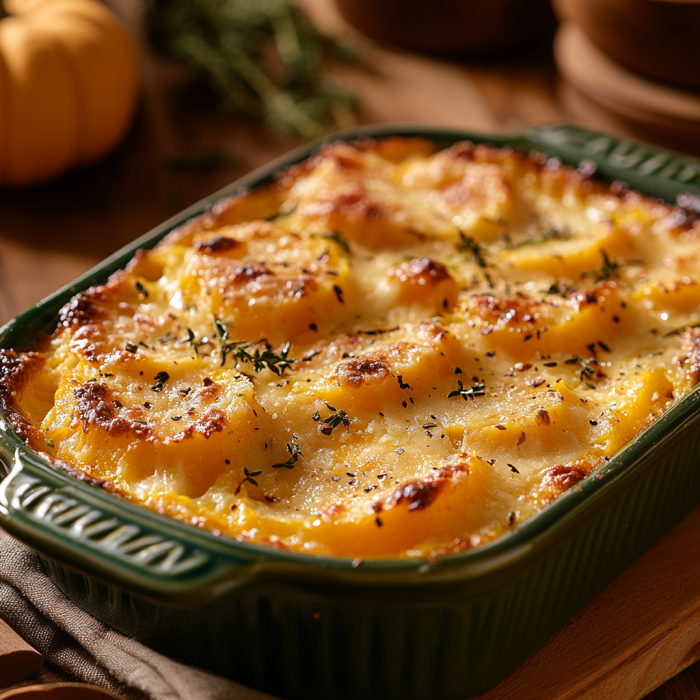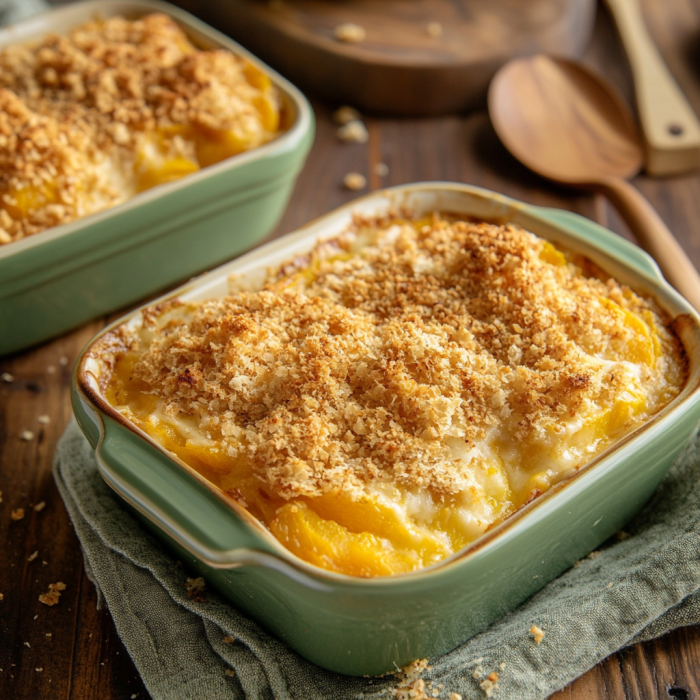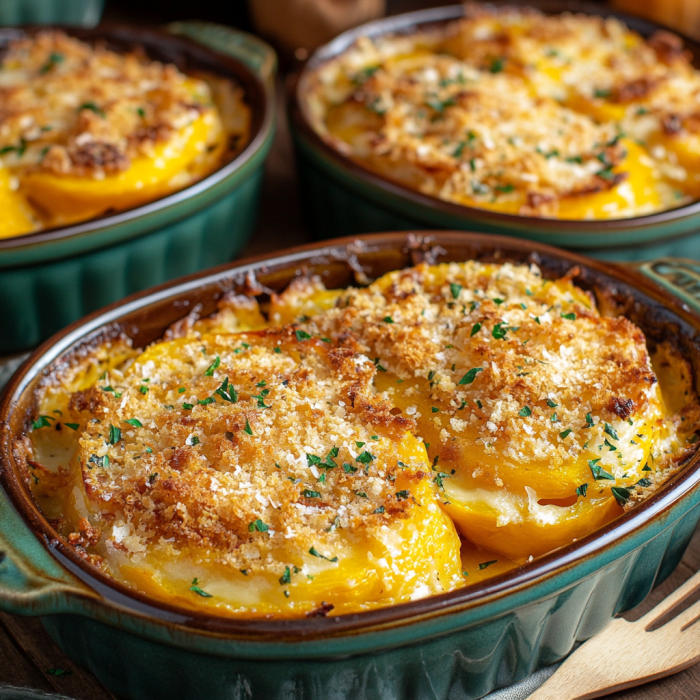Introduction
Squash casserole is a beloved dish that has been gracing Southern tables for generations. With its creamy texture, cheesy goodness, and crunchy topping, it’s no wonder this dish has become a staple at family gatherings and holiday feasts. Whether you’re new to making casseroles or a seasoned cook, this article will guide you through everything you need to know about squash casserole, from ingredients and preparation to cooking tips and variations. Let’s dive into the delicious world of squash casserole!
Introduction and Overview
Introduction
Squash casserole is more than just a side dish; it’s a symbol of Southern hospitality and comfort. This dish combines tender squash, onions, and a cheesy, creamy sauce, all topped with a buttery, crispy layer of crackers or breadcrumbs. It’s versatile enough to be a main course for vegetarians or a delightful side dish for any meal.
Squash, particularly yellow squash, is the star of this casserole. Its mild flavor and soft texture make it perfect for soaking up the rich, cheesy sauce. Traditionally, Southern squash casserole is baked to perfection, resulting in a golden-brown topping that adds just the right amount of crunch.
Ingredients and Preparation
Ingredients
To create the perfect squash casserole, you’ll need a handful of essential ingredients:
- Yellow squash: The main ingredient, bringing a subtle sweetness and tender texture.
- Onions: For added flavor and depth.
- Cheddar cheese: Sharp or mild, it melts beautifully into the casserole.
- Crackers or breadcrumbs: For that irresistible crispy topping.
- Eggs: To bind everything together.
- Sour cream or mayonnaise: Adding creaminess and richness.
- Butter: For sautéing and enhancing the topping’s flavor.
- Seasonings: Salt, pepper, and any preferred herbs or spices.
Feel free to customize with additional ingredients like garlic, bell peppers, or even a sprinkle of Parmesan cheese for extra flavor. For another delicious creamy recipe, you might want to check out this ultimate guide to homemade Alfredo sauce.
Preparation Steps
Preparing a squash casserole is straightforward, but a few tips can make all the difference:
- Preheat your oven: Set it to 350°F (175°C) to ensure it’s ready for baking.
- Prepare the squash: Wash, trim, and slice the squash into thin rounds. This ensures even cooking.
- Sauté the onions and squash: In a large skillet, melt butter over medium heat. Add the onions and squash, cooking until tender and lightly browned.
- Mix the ingredients: In a large bowl, combine the sautéed squash and onions with sour cream, beaten eggs, and shredded cheddar cheese. Season with salt and pepper.
- Prepare the topping: Crush crackers or breadcrumbs and mix with melted butter. This creates the crunchy topping.
- Assemble the casserole: Pour the squash mixture into a greased baking dish. Spread the cracker topping evenly over the top.
- Bake: Place the dish in the preheated oven and bake for 30-40 minutes, or until the top is golden brown and the casserole is bubbly.
Cooking squash casserole is a breeze, but remember, the key is in the details. Ensuring the squash is well-cooked and the topping is perfectly crispy will make your casserole a hit at any gathering.

Cooking Techniques and Tips
Cooking Techniques
When it comes to cooking squash casserole, using the right techniques can make all the difference. Here are some tips to ensure your casserole turns out perfectly every time:
- Sautéing the Squash: Sautéing helps to soften the squash and release some of its moisture. This step prevents the casserole from becoming too watery. Cook the squash until it’s tender and lightly browned for the best flavor.
- Using a Skillet: A large, heavy-bottomed skillet works best for sautéing. It ensures even cooking and helps the squash develop a nice, caramelized exterior.
- Baking the Casserole: Baking the casserole at 350°F (175°C) allows it to cook evenly without drying out. If you prefer a crunchier topping, you can broil the casserole for the last few minutes of baking.
- Mixing the Ingredients: Combine the sautéed squash and onions with the other ingredients while they’re still warm. This helps the cheese melt evenly and blend well with the other components.
- Crushing the Crackers: For a finer topping, crush the crackers in a food processor. If you prefer a chunkier texture, you can crush them by hand using a rolling pin.
Tips for the Perfect Casserole
Achieving the perfect squash casserole involves more than just following a recipe. Here are some additional tips to help you along the way:
- Don’t Overcook the Squash: Overcooking can make the squash mushy. Aim for a tender yet firm texture before mixing it into the casserole.
- Drain Excess Moisture: If your squash releases a lot of moisture, drain it on paper towels before adding it to the casserole. This step ensures a firmer, less watery dish.
- Balancing Flavors: Taste the mixture before baking and adjust the seasonings as needed. Adding a touch of garlic powder or paprika can enhance the overall flavor profile.
- Cheese Selection: While cheddar is the traditional choice, don’t be afraid to experiment with other cheeses like Monterey Jack, Gruyère, or even a bit of Parmesan for a unique twist.
- Resting Time: Allow the casserole to rest for a few minutes after baking. This helps the ingredients set, making it easier to serve and enhancing the flavors.
By following these techniques and tips, you’ll ensure that your squash casserole is deliciously creamy with a perfectly crispy topping every time.
Variations and Customizations
Popular Variations
Squash casserole is a versatile dish that lends itself well to various interpretations. Here are some popular variations to try:
- Cheesy Squash Casserole: Double the cheese for an extra gooey, melty experience. Combine sharp cheddar with a milder cheese like mozzarella or Monterey Jack.
- Southern-Style Squash Casserole: Stick to the classic Southern recipe with yellow squash, onions, cheddar cheese, and a Ritz cracker topping. This version is perfect for those who love traditional flavors.
- Healthy Alternatives: For a lighter version, use low-fat sour cream and cheese. Substitute whole-grain crackers or breadcrumbs for a healthier topping.
Customizations for Dietary Needs
Meeting dietary needs doesn’t mean sacrificing flavor. Here are some adjustments to make squash casserole suitable for various diets:
- Gluten-Free: Use gluten-free crackers or breadcrumbs for the topping. Ensure all other ingredients are gluten-free as well.
- Vegan: Replace cheese with a vegan cheese alternative and use a plant-based sour cream or cashew cream. Skip the eggs or use a vegan egg substitute.
- Low-Fat: Opt for low-fat cheese and sour cream. Reduce the amount of butter used in the recipe or use a heart-healthy oil like olive oil.
- Low-Sodium: Use reduced-sodium cheese and crackers. Season with herbs and spices instead of salt to enhance the flavor.
Experimenting with these variations and customizations can help you create a squash casserole that suits your taste and dietary preferences perfectly.
By mastering these techniques and exploring different variations, you can make a squash casserole that will be a hit at any meal. Whether you’re sticking to the classic recipe or trying a new twist, this dish is sure to become a favorite.

Serving Suggestions
Side Dishes and Complements
Pairing your squash casserole with the right side dishes can elevate your meal to the next level. Here are some ideas to complement your casserole:
- Green Salad: A fresh, crisp green salad with a light vinaigrette balances the richness of the casserole. Add ingredients like cherry tomatoes, cucumbers, and red onions for extra crunch and flavor.
- Roasted Vegetables: Roasting vegetables like carrots, Brussels sprouts, or asparagus brings out their natural sweetness and adds a colorful, healthy side to your meal.
- Mashed Potatoes: Creamy mashed potatoes are a comforting side dish that pairs well with the cheesy, creamy texture of the squash casserole.
- Grilled Chicken: For a heartier meal, serve the casserole with grilled chicken breast seasoned with herbs and spices. The simplicity of the grilled chicken allows the casserole to shine.
- Cornbread: A slice of warm cornbread complements the Southern flavors of the casserole. Consider adding a touch of honey butter for a sweet finish.
By choosing the right side dishes, you can create a well-rounded and satisfying meal that highlights the deliciousness of your squash casserole.
Presentation Tips
Presentation is key to making your squash casserole look as good as it tastes. Here are some tips to serve it attractively:
- Garnishing: Sprinkle fresh herbs like parsley, chives, or thyme over the top of the casserole before serving. This adds a pop of color and a hint of freshness.
- Serve in a Beautiful Dish: Using a decorative baking dish can enhance the visual appeal. Choose one that complements your table setting.
- Individual Portions: If you’re serving guests, consider baking the casserole in individual ramekins. This not only looks elegant but also makes serving easier.
- Layering the Topping: Ensure the cracker or breadcrumb topping is spread evenly and crisply browned. This adds to the visual appeal and provides a satisfying crunch with each bite.
- Plating: Serve each portion neatly on a plate, perhaps with a small sprig of herbs on the side. Clean the edges of the plate for a professional presentation.
By choosing the right side dishes, you can create a well-rounded and satisfying meal that highlights the deliciousness of your squash casserole. For more casserole recipes, you might also enjoy this easy taco casserole recipe.
Nutritional Information and Benefits
Nutritional Breakdown
Understanding the nutritional content of your squash casserole can help you make informed dietary choices. Here’s a typical breakdown for a standard serving:
- Calories: Approximately 250-300 per serving, depending on the ingredients used.
- Carbohydrates: Around 20-25 grams, mostly from the squash and topping.
- Protein: About 6-10 grams, primarily from the cheese and eggs.
- Fat: Roughly 15-20 grams, with variations based on cheese and butter quantities.
- Fiber: 2-3 grams, providing some digestive benefits.
- Vitamins and Minerals: Rich in vitamins A and C from the squash, calcium from the cheese, and some iron and potassium.
Health Benefits
Squash casserole offers several health benefits, thanks to its nutritious ingredients:
- Vitamin-Rich: Squash is packed with vitamins A and C, essential for immune function, skin health, and vision.
- Mineral Content: Squash provides potassium, which helps regulate blood pressure, and magnesium, important for muscle and nerve function.
- Antioxidants: Both squash and onions contain antioxidants that combat oxidative stress and may reduce the risk of chronic diseases.
- Calcium: Cheese contributes to the casserole’s calcium content, important for bone health.
- Fiber: The fiber in squash aids in digestion and can help maintain a healthy weight.
By enjoying squash casserole, you’re not only indulging in a comforting and delicious dish but also reaping various health benefits from its wholesome ingredients. For those looking to maintain a balanced diet, you might find healthy meals for weight loss helpful.
Squash Casserole in Culture
Historical Background
The history of Southern cuisine is rich and varied, and squash casserole holds a special place in it. Originating in the Southern United States, this dish became a way to utilize the abundant summer squash harvest. Over time, it evolved from a simple vegetable dish to a beloved casserole, thanks to the addition of cheese and a crispy topping.
Squash casserole gained popularity in the mid-20th century, particularly in Southern households. It became a staple at family gatherings, potlucks, and holiday dinners, symbolizing comfort and hospitality. The combination of readily available ingredients and ease of preparation contributed to its widespread appeal.
Squash Casserole in Modern Cuisine
In modern times, squash casserole continues to be a favorite in Southern cooking. It has also gained appreciation beyond the South, with variations appearing in different regions and culinary contexts. Notable chefs and food bloggers have put their own spin on the classic recipe, introducing new flavors and techniques while preserving its comforting essence.
Restaurants specializing in Southern cuisine often feature squash casserole on their menus, showcasing it as a quintessential dish. Whether enjoyed at a family gathering or a trendy eatery, squash casserole remains a beloved part of America’s culinary landscape.
By understanding the cultural significance and historical roots of squash casserole, you can appreciate this dish even more and perhaps share its rich history with your guests.

Frequently Asked Questions
FAQs Section
- What type of squash is best for casserole? Yellow squash is typically used for its mild flavor and tender texture. Zucchini can also be used as an alternative.
- Can squash casserole be made ahead of time? Yes, you can prepare the casserole up to the baking step and refrigerate it. When ready to bake, allow it to come to room temperature first.
- How do I store and reheat leftovers? Store leftovers in an airtight container in the refrigerator for up to three days. Reheat in the oven at 350°F until warmed through.
- Can I freeze squash casserole? Yes, squash casserole can be frozen. Prepare it up to the baking step, wrap it tightly, and freeze. Thaw in the refrigerator before baking.
- How do I make a vegan squash casserole? Use vegan cheese and a plant-based sour cream substitute. Skip the eggs or use a vegan egg replacer.
By addressing these common questions, you can help ensure that anyone attempting to make a squash casserole has all the information they need for success.
Conclusion
Final Thoughts
Squash casserole is a delightful dish that embodies the essence of Southern comfort food. Its creamy, cheesy interior and crispy, buttery topping make it a favorite at family gatherings, holiday feasts, and everyday dinners. Whether you’re sticking to a traditional recipe or experimenting with variations and customizations, squash casserole is sure to impress.
This dish is not only delicious but also versatile, accommodating various dietary needs and preferences. From gluten-free and vegan options to low-fat and low-sodium versions, there’s a squash casserole for everyone. The health benefits of squash, combined with the satisfying flavors of cheese and a crunchy topping, make this casserole a nutritious and enjoyable addition to any meal.
By following the tips and techniques outlined in this article, you’ll be well on your way to mastering the art of squash casserole. So, roll up your sleeves, gather your ingredients, and get ready to create a dish that will warm hearts and fill bellies. Happy cooking!

